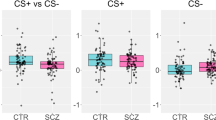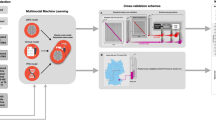Abstract
It is hypothesized that due to an abnormal functioning of the reward system patients with schizophrenia form context-inappropriate associations. It has been shown that the dopamine target regions, especially the ventral striatum, are critical in the formation of reward associations. We wanted to examine how the ventral striatum responds as patients learn reward-related associations and how this neural response is linked to objective and subjective behavioral measures. Functional magnetic resonance imaging (fMRI) Blood oxygen level dependent (BOLD) responses were examined using aversive Pavlovian learning in 13 medicated patients with schizophrenia and 13 matched healthy controls. Colored circles served as conditioned stimulus (CS+) while a loud, individually adjusted, noise served as the unconditioned stimulus. Circles of another color served as neutral comparators (CS−). Subjective indices were assessed by a post-scan self-report, and galvanic skin responses (GSR) were used as objective measures of associative learning. fMRI data were analyzed using a random effects model in SPM2. Patients showed inappropriately strong activations in the ventral striatum in response to the neutral stimulus (CS−) as compared to the healthy controls. Consistent with this neural evidence of aberrant learning, patients also showed evidence of abnormal learning by self-report and as indexed by GSR. The main finding here is that patients with schizophrenia, when exposed to neutral stimuli in a threatening situation, show an abnormal pattern of learning. The aberrant activations and response are consistent with the idea that patients aberrantly assign motivational salience to neutral stimuli, and this process may be one of the aberrations that predisposes them to psychosis.
Similar content being viewed by others
Log in or create a free account to read this content
Gain free access to this article, as well as selected content from this journal and more on nature.com
or
References
Arnt J, Skarsfeldt T (1998). Do novel antipsychotics have similar pharmacological characteristics? A review of the evidence. Neuropsychopharmacology 18: 63–101.
Boucsein W (1992). Electrodermal Activity. Planum Press: New York.
Crespo-Facorro B, Paradiso S, Andreasen NC, O'Leary DS, Watkins GL, Ponto LL et al (2001). Neural mechanisms of anhedonia in schizophrenia: a PET study of response to unpleasant and pleasant odors. JAMA 286: 427–435.
Evans AC, Collins DL, Mills SR, Brown ED, Kelly RL, Peters TM (1993). 3D statistical neuroanatomical models from 305 MRI volumes. Proceedings of the Institute of Electrical and Electronics Engineering—Nuclear Science Symposium and Medical Imaging 3: 1813–1817.
Friston KJ, Holmes AP, Poline JB, Grasby PJ, Williams SC, Frackowiak RS et al (1995). Analysis of fMRI time-series revisited. Neuroimage 2: 45–53.
Glover GH, Thomason ME (2004). Improved combination of spiral-in/out images for BOLD fMRI. Magn Reson Med 51: 863–868.
Gray JA, Moran PM, Grigoryan G, Peters SL, Young AM, Joseph MH (1997). Latent inhibition: the nucleus accumbens connection revisited. Behav Brain Res 88: 27–34.
Hofer E, Doby D, Anderer P, Dantendorfer K (2001). Impaired conditional discrimination learning in schizophrenia. Schizophr Res 51: 127–136.
Holt DJ, Kunkel L, Weiss AP, Goff DC, Wright CI, Shin LM et al (2006a). Increased medial temporal lobe activation during the passive viewing of emotional and neutral facial expressions in schizophrenia. Schizophr Res 82: 153–162.
Holt DJ, Titone D, Long LS, Goff DC, Cather C, Rauch SL et al (2006b). The misattribution of salience in delusional patients with schizophrenia. Schizophr Res 83: 247–256.
Howe ES (1958). GSR conditioning in anxiety states, normals, and chronic functional schizophrenic subjects. J Abnorm Psychol 56: 183–189.
Jensen J, McIntosh AR, Crawley AP, Mikulis DJ, Remington G, Kapur S (2003). Direct activation of the ventral striatum in anticipation of aversive stimuli. Neuron 40: 1251–1257.
Jensen J, Smith AJ, Willeit M, Crawley AP, Mikulis DJ, Vitcu I et al (2007). Separate brain regions code for salience versus valence during reward prediction in humans. Human Brain Mapping 28: 294–302.
Juckel G, Schlagenhauf F, Koslowski M, Filonov D, Wustenberg T, Villringer A et al (2006a). Dysfunction of ventral striatal reward prediction in schizophrenic patients treated with typical, not atypical, neuroleptics. Psychopharmacology (Berlin) 187: 222–228.
Juckel G, Schlagenhauf F, Koslowski M, Wustenberg T, Villringer A, Knutson B et al (2006b). Dysfunction of ventral striatal reward prediction in schizophrenia. Neuroimage 29: 409–416.
Kapur S (2003). Psychosis as a state of aberrant salience: a framework linking biology, phenomenology, and pharmacology in schizophrenia. Am J Psychiatry 160: 13–23.
King R, Barchas JD, Huberman BA (1984). Chaotic behavior in dopamine neurodynamics. Proc Natl Acad Sci USA 81: 1244–1247.
Kosmidis MH, Breier A, Fantie BD (1999). Avoidance learning in schizophrenia: a dissociation between the effects of aversive and non-aversive stimuli. Schizophr Res 38: 51–59.
Lynn R (1963). Russian theory and research on schizophrenia. Psychol Bull 60: 486–498.
McClure SM, Berns GS, Montague PR (2003). Temporal prediction errors in a passive learning task activate human striatum. Neuron 38: 339–346.
Menon M, Jensen J, Vitcu I, Graff-Guerro A, Crawley AP, Smith MA et al (in press). Temporal difference modeling of the BOLD response during aversive conditioning in humans: effects of dopaminergic modulation. Biological Psychiatry.
Miller R (1984). Major psychosis and dopamine: controversial features and some suggestions. Psychol Med 14: 779–789.
O'Doherty J, Dayan P, Schultz J, Deichmann R, Friston K, Dolan RJ (2004). Dissociable roles of ventral and dorsal striatum in instrumental conditioning. Science 304: 452–454.
O'Doherty JP, Dayan P, Friston K, Critchley H, Dolan RJ (2003). Temporal difference models and reward-related learning in the human brain. Neuron 38: 329–337.
Paradiso S, Andreasen NC, Crespo-Facorro B, O'Leary DS, Watkins GL, Boles Ponto LL et al (2003). Emotions in unmedicated patients with schizophrenia during evaluation with positron emission tomography. Am J Psychiatry 160: 1775–1783.
Pessiglione M, Seymour B, Flandin G, Dolan RJ, Frith CD (2006). Dopamine-dependent prediction errors underpin reward-seeking behaviour in humans. Nature 442: 1042–1045.
Sears LL, Andreasen NC, O'Leary DS (2000). Cerebellar functional abnormalities in schizophrenia are suggested by classical eyeblink conditioning. Biol Psychiatry 48: 204–209.
Shaner A (1999). Delusions, superstitious conditioning and chaotic dopamine neurodynamics. Med Hypotheses 52: 119–123.
Spain B (1966). Eyelid conditioning and arousal in schizophrenic and normal subjects. J Abnorm Psychol 71: 260–266.
Taylor SF, Liberzon I, Decker LR, Koeppe RA (2002). A functional anatomic study of emotion in schizophrenia. Schizophr Res 58: 159–172.
Taylor SF, Phan KL, Britton JC, Liberzon I (2005). Neural response to emotional salience in schizophrenia. Neuropsychopharmacology 30: 984–995.
Vaitl D, Lipp O, Bauer U, Schuler G, Stark R, Zimmermann M et al (2002). Latent inhibition and schizophrenia: pavlovian conditioning of autonomic responses. Schizophr Res 55: 147–158.
Wadenberg ML, Soliman A, VanderSpek SC, Kapur S (2001). Dopamine D(2) receptor occupancy is a common mechanism underlying animal models of antipsychotics and their clinical effects. Neuropsychopharmacology 25: 633–641.
Zink CF, Pagnoni G, Chappelow J, Martin-Skurski M, Berns GS (2006). Human striatal activation reflects degree of stimulus saliency. Neuroimage 29: 977–983.
Zink CF, Pagnoni G, Martin ME, Dhamala M, Berns GS (2003). Human striatal response to salient nonrewarding stimuli. J Neurosci 23: 8092–8097.
Zink CF, Pagnoni G, Martin-Skurski ME, Chappelow JC, Berns GS (2004). Human striatal responses to monetary reward depend on saliency. Neuron 42: 509–517.
Acknowledgements
This study was supported by a grant from the Canadian Institutes of Health Research.
Author information
Authors and Affiliations
Corresponding author
Additional information
DISCLOSURE/CONFLICT OF INTEREST
The authors declare no personal financial interest that could be perceived as constituting a potential conflict of interest.
Rights and permissions
About this article
Cite this article
Jensen, J., Willeit, M., Zipursky, R. et al. The Formation of Abnormal Associations in Schizophrenia: Neural and Behavioral Evidence. Neuropsychopharmacol 33, 473–479 (2008). https://doi.org/10.1038/sj.npp.1301437
Received:
Revised:
Accepted:
Published:
Issue date:
DOI: https://doi.org/10.1038/sj.npp.1301437
Keywords
This article is cited by
-
Impairment in acquisition of conditioned fear in schizophrenia
Neuropsychopharmacology (2022)
-
The prediction-error hypothesis of schizophrenia: new data point to circuit-specific changes in dopamine activity
Neuropsychopharmacology (2022)
-
Neural alterations of emotion processing in atypical trajectories of psychotic-like experiences
Schizophrenia (2022)
-
Schizotypal personality traits and the social learning of fear
Scientific Reports (2021)
-
The Bayesian Brain and Psychoanalytic Dimensions of Hyper-salience in Psychosis
Current Behavioral Neuroscience Reports (2020)



